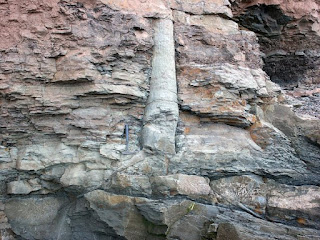Solving the Polystrate Fossil Problem
While the devastating difficulty of dinosaur soft tissues cannot be ignored or hidden, uniformitarian geologists have a lesser-known problem: polystrate fossils. Acolytes of the secular science industry like to point out that the phrase comes from creationists. Poison the well much, Marcia?
Polystrate fossils are trees that have been fossilized in rock layers that are supposedly millions of years old. Secular geologists also claim that the trees grew in place. However, they do not show signs of partial decay while fossilizing during the requisite years. Also, these fossils are found in coal seams.
.jpg) |
| Polystrate tree fossil in Joggins formation, Wikimedia Commons / Michael C. Rygel (CC BY-SA 3.0) |
Fossil tree trunks are regularly found sitting vertically across multiple geological strata or layers (fig. 1). They are called polystrate (poly = many, strate = strata) fossils. Uniformitarian scientists say they grew in place. They envisage that, as sediments slowly accumulated, the tree trunks were eventually covered by layers of sediments, which later hardened into sedimentary rock. They argue that trees ‘growing in place’ support their philosophy of uniformitarianism (a slow and gradual history) and contradict a Flood origin. A closer examination of polystrate fossils reveals that the Flood provides a better explanation, namely that the trees were deposited from floating log mats.
You can get straight to the rest of the article by clicking on "Polystrate trees and ‘fossil forests’ explained by Flood log mats." If not, here are some selections by Georg Philipp Telemann.